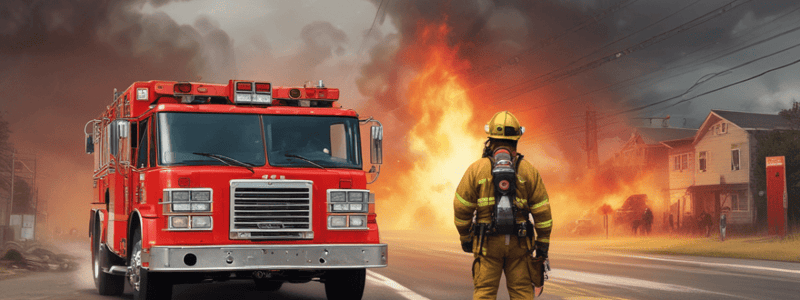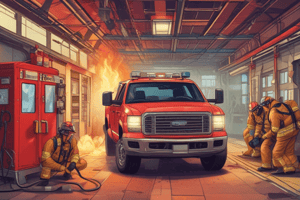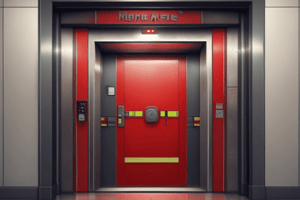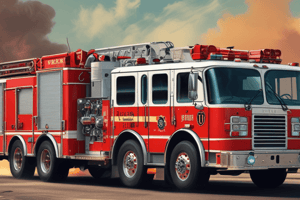Podcast
Questions and Answers
What is the primary responsibility of the Rehab Sector Officer and/or Command?
What is the primary responsibility of the Rehab Sector Officer and/or Command?
- To assign rehab sector boundaries
- To provide medical treatment to crew members
- To determine resources for the rehab sector (correct)
- To collect passports from crews
What is the role of the Rehab Sector in terms of Accountability?
What is the role of the Rehab Sector in terms of Accountability?
- To provide medical treatment to crew members
- To track pulse rates of crew members
- To continue accountability and assign a member to collect passports from crews (correct)
- To assign rehab sector boundaries
What is the purpose of the Rehabilitation Sector?
What is the purpose of the Rehabilitation Sector?
- To assess and monitor personnel's vital signs and provide treatment as needed (correct)
- To provide a place for personnel to rest
- To provide food and water to personnel
- To provide medical treatment to personnel
What is the primary purpose of the Rehabilitation Sector?
What is the primary purpose of the Rehabilitation Sector?
What is the role of the Designated Sector Officer in the Rehab Sector?
What is the role of the Designated Sector Officer in the Rehab Sector?
When is a Rehab Truck dispatched?
When is a Rehab Truck dispatched?
What happens to personnel assigned to the Rehab Sector?
What happens to personnel assigned to the Rehab Sector?
What is the responsibility of the Incident Commander regarding the Rehab Sector?
What is the responsibility of the Incident Commander regarding the Rehab Sector?
What services are provided in the Rehab Sector?
What services are provided in the Rehab Sector?
What is the concept used to establish and manage the Rehab Sector?
What is the concept used to establish and manage the Rehab Sector?
What happens when multiple Rehab Sectors are established?
What happens when multiple Rehab Sectors are established?
Flashcards are hidden until you start studying
Study Notes
Rehabilitation Sector Policy
- The Phoenix Fire Department's policy is to prevent injuries resulting from extended field operations under adverse conditions.
- No member will be permitted to continue emergency operations beyond safe levels of physical or mental exertion.
Rehabilitation Sector Procedure
- The Rehabilitation Sector (radio designation REHAB) is used to evaluate and assist personnel suffering from the effects of sustained physical or mental exertion during emergency operations.
- The sector provides a specific area for personnel to assemble and receive:
- Assessment of vital signs
- Revitalization (rest, hydration, refreshments, and temperature regulation)
- Medical evaluation and treatment of injuries, if needed
- Transportation for those requiring treatment at medical facilities
- Reassignment as needed
Rehabilitation Sector Team
- A Rehab Team concept will be used to establish and manage the Rehab Sector.
- The team consists of:
- Rehab Truck
- Utility Truck
- Rescue
- ALS Company
- Designated Sector Officer
- C959, as needed
- Health Center officer, as needed
Incident Commander Responsibilities
- The Incident Commander makes an early determination of incidents requiring Rehab Sector.
- The commander determines the need for multiple Rehab Sectors, and each sector assumes a geographic designation consistent with the location at the incident site.
Rehabilitation Sector Location and Boundaries
- The Rehab Sector is located in a functional location for crew access.
- City buses may be called to the incident scene to provide cooling or shelter.
- The sector has a defined boundary with only one entry point.
- The sector is divided into four functions: Assessment, Hydration and Replenishment, Medical Treatment and Transport, and Documentation.
Function A: Assessment
- The initial entry point and assessment area where members remove their Personal Protective Equipment prior to entry.
- Rehab Sector Officer assigns a member to collect passports from crews and take a pulse rate on all crew members.
- The purpose of this area is to identify members who may be in need of more attention than just a recovery period.
Function B: Hydration and Replenishment
- Rehab personnel provide supplemental cooling devices, fluid and electrolyte replacement, and nourishment.
- Members rest and rehydrate with their crew members and are re-evaluated for pulse rate after 20 minutes.
Function C: Medical Treatment and Transport
- ALS crews and Rescue manage this function.
- Members receive evaluation and treatment for overexertion and injuries.
- Crews follow standard ALS Protocol and advise the Rehab Sector Officer of the need for medical treatment and/or transportation requirements of personnel due to physical condition.
Function D: Documentation
- Time-in and time-out for members/crews entering or leaving the rehabilitation area are tracked with vitals.
- Any member requiring further evaluation beyond 20 minutes is documented on an EMS patient care report.
- Where emergency medical care is provided, an EMS Patient Care Report is generated and a copy is placed in the member's employee health record.
Function E: Reassignment
- The Health Center staff officer may be available in this section.
- This section determines a crew's readiness for reassignment.
- Diligent efforts and face-to-face communication with the Rehab Sector Officer are required.
- Rehab crews advise the Rehab Sector Officer of all companies' status for reassignment and crews that are running short or without a company officer.
Vital Signs and Assessment Standards for REHAB
- ALS crew in Function C pay close attention to members' physical observations, including:
- Chest pain, dizziness, shortness of breath, weakness, nausea, or headache
- General complaints such as cramps, aches, and pains, rate of perceived exertion
- Symptoms of heat or cold-related stress
- Changes in gait, speech, or behavior
- Alertness and orientation to person, place, and time
- Skin color
- Obvious injuries
Reassignment Criteria
- Members must meet the following criteria to be reassigned:
- Heart rate below 100 bpm with no irregular beats
- Systolic BP below 160
- Diastolic BP below 100
- Respiratory rate between 12-20 per minute
- No abnormal neurological findings
- No complaints
Studying That Suits You
Use AI to generate personalized quizzes and flashcards to suit your learning preferences.




